Multiple choice question for engineering
Set 1
1. Which of the following is not a refractory sand?
a) Olivine
b) Silica Sand
c) Dolomite
d) Barium Chloride
Answer
Answer: d [Reason:] Among the following, Barium Chloride is not a refractory sand, as it is counted under foundry fluxes, whereas all remaining sands are refractory sands.
2. Which refractory sand has the best moulding material?
a) Silica sand
b) Magnesite
c) Zircon
d) Olivine
Answer
Answer: a [Reason:] Silica sands are considered to be having the best moulding material. It has its occurrence in variety of crystalline modifications.
3. Ganister is another name for which sand?
a) Magnesite
b) Zircon
c) Silica sand
d) Dolomite
Answer
Answer: c [Reason:] Ganister is another name for silica sand. As, silica is obtained from carbon-ferrous sandstone, also known as dinas.
4. At what temperature, does quartz melt completely?
a) 1725°C
b) 1925°C
c) 1825°C
d) 2025°C
Answer
Answer: a [Reason:] Quartz gets melted completely at 1725°C. After reaching this temperature, the quartz would then start undergoing transformations.
5. Which of the following is the most porous sand?
a) Silica sand
b) Zircon
c) Olivine
d) Dolomite
Answer
Answer: a [Reason:] Even when the silica sand are packed as mould cavity, they show enough porosity and permeability, and hence are porous sands.
6. At what temperature does the silica sand start expanding thermally?
a) 918°F
b) 843°F
c) 1063°F
d) 1124°F
Answer
Answer: c [Reason:] It is one of the disadvantages of silica sand, that it has its thermal expansion temperature at 1063°F. At this temperature, the volume of the sand starts to increase.
7. Which of the following factor is not to be considered while selecting a refractory?
a) Conductivity
b) Expansion
c) Size of the particle
d) Permeability
Answer
Answer: d [Reason:] Conductivity, thermal expansion and size of the particle are few of the factors needed to be considered while selecting a refractory and not permeability.
8. Which sand is generally used repetitively for mould making?
a) Silica sand
b) Zircon
c) Olivine
d) Dolomite
Answer
Answer: a [Reason:] Silica sand has this as one of its advantages, that it can be used again and again for making moulds. This repetitive use of silica sand, makes production even more inexpensive.
9. Which of the following sand is freely available?
a) Silica sand
b) Zircon
c) Olivine
d) Dolomite
Answer
Answer: a [Reason:] Silica sand has this as one of its advantages, that it is available without any difficulty in abundance. Hence, the cost of silica sand is also low.
10. Silica sand is expensive.
a) True
b) False
Answer
Answer: b [Reason:] Silica sand is most freely available, without any difficulty in abundance. Hence, the cost of this sand is low.
Set 2
1. Using what is the lining of the reverberatory furnace done?
a) Acid
b) Base
c) Water
d) Salt
Answer
Answer: a [Reason:] The air furnace or the reverberatory furnace, is an acid-lined reverberatory furnace. This furnace can be used for the manufacture of malleable iron and gray iron castings.
2. Which coal is used as a fuel in air furnace?
a) Lignite
b) Bituminous
c) Anthracite
d) Peat
Answer
Answer: b [Reason:] In the air furnace or the reverberatory furnace, a pulverized bituminous lump coal is used as a fuel. If not a bituminous coal, oils are used for the same purpose.
3. What is the minimum capacity of an air furnace?
a) 5 tons
b) 7 tons
c) 9 tons
d) 11 tons
Answer
Answer: a [Reason:] Reverberatory furnace is used for the production of malleable iron and gray iron castings. The minimum capacity of an air furnace or a reverberatory furnace is around 5 tons.
4. What is the maximum capacity of an air furnace?
a) 35 tons
b) 70 tons
c) 19 tons
d) 50 tons
Answer
Answer: a
5. In the following figure of the air furnace, what does the question mark represent?
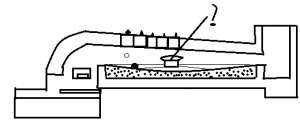
a) Fire bridge
b) Skimming door
c) Hearth
d) Bungs
Answer
Answer: b [Reason:] The given figure is that of an air furnace or a reverberatory furnace. The question mark in the picture is depicting a skimming door.
6. In the following figure of the air furnace, what does the question mark represent?
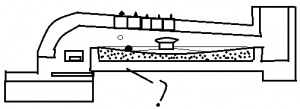
a) Bungs
b) Hearth
c) Fire bridge
d) Fire bars
Answer
Answer: c [Reason:] The question mark in the picture is depicting a fire bridge. This bridge is used for holding the molten metal. The given figure is that of an air furnace or a reverberatory furnace.
7. In the following figure of the air furnace, what does the question mark represent?

a) Bungs
b) Fire place
c) Fire bars
d) Hearth
Answer
Answer: d [Reason:] The question mark in the picture is depicting a hearth. The given figure is that of an air furnace or a reverberatory furnace. This hearth finds its place above the fire bridge in the apparatus.
8. In the following figure of the air furnace, what does the question mark represent?
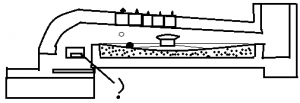
a) Firing door
b) Firing place
c) Firing bridge
d) Firing bars
Answer
Answer: a [Reason:] The given figure is that of an air furnace or a reverberatory furnace. The question mark in the picture is depicting a firing door. Air and fuel are flown through this door only.
9. In the following figure of the air furnace, what does the question mark represent?
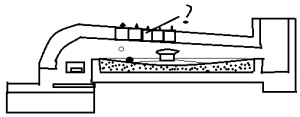
a) Hearth
b) Sight holes
c) Bungs
d) Fire bars
Answer
Answer: c [Reason:] The question mark in the picture is depicting a few bungs. These bungs insure the proper charging of the metal. The given figure is that of an air furnace or a reverberatory furnace.
10. Malleable iron can be produced using reverberatory furnace.
a) True
b) False
Answer
Answer: a [Reason:] Malleable iron and high test gray iron castings are few such examples which can be produced using the reverberatory furnace or the air furnace.
Set 3
1. Which of the following material is not melted by an indirect electric arc furnace?
a) Steel
b) Copper
c) Cast iron
d) Zinc
Answer
Answer: b [Reason:] An indirect electric arc furnace cannot be used for melting zinc, but for melting steel, cast iron or copper and its alloys, this method can be used.
2. What is the maximum capacity of a rocking furnace?
a) 0.5 ton
b) 1 ton
c) 2 tons
d) 3 tons
Answer
Answer: c [Reason:] An indirect arc furnace or a rocking furnace has its capacity ranging from a few kilograms to up to 2 tons. It is generally used for smaller melts.
3. Which of the following factors keeps the liquid metal level below the pouring sprout?
a) Angle of rocking furnace
b) Velocity of rocking furnace
c) Mounting distance
d) Temperature of the metal
Answer
Answer: a [Reason:] In the operation of indirect electric arc furnace, the liquid metal level has to be kept below the pouring sprout level. To accomplish this, the angle of rocking adjusts itself in different manners and maintains the liquid level.
4. How does the heat transfer take place in the rocking furnace?
a) Radiation-conduction
b) Conduction-convection
c) Convection-radiation
d) Only radiation
Answer
Answer: a [Reason:] In a rocking furnace, the heat is first radiated from the hot refractory walls and the arc and conduction when the furnace starts rocking from the wall lining.
5. Which of the following is not valid for rocking furnace operation?
a) Causes overheating
b) Uniform composition of melt
c) Damage to refractory lining
d) Fast melting
Answer
Answer: a [Reason:] In an indirect electric arc furnace, the rocking of furnace causes the melting to speed up, it also causes uniform composition of melt and does some damage to the refractory lining. This process does not cause overheating, instead it avoids it.
6. Which metal is charged before the actual operation in a rocking furnace begins?
a) Gray iron
b) Copper
c) Pig iron
d) Zinc
Answer
Answer: c [Reason:] Inside the furnace, before beginning the actual process, the pig iron is charged. Above this charged pig iron, the scrap is then placed.
7. The electrodes used in rocking furnace are typically made up of which material?
a) Aluminium
b) Zinc
c) Magnesium
d) Graphite
Answer
Answer: d [Reason:] In an indirect electric arc furnace, the electrodes are made up of graphite generally. When the scrap is placed, these electrodes are brought near for the current to jump.
8. Where does the diameter of the electrode, in rocking furnace become low?
a) Near cathode
b) Near anode
c) In the middle
d) Between cathode and the mid
Answer
Answer: c [Reason:] The graphite electrode is designed in such a way that its diameter gets reduced at the middle of the electrode. This reduction in diameter causes a high amount of resistance in the electrode, hence generating large amount of heat.
9. Low cost scrap metal can be used for rocking furnace.
a) True
b) False
Answer
Answer: a [Reason:] It is one of the advantages of the indirect electric arc furnace, that it does not essentially need a costly metal, but can operate even on low cost scrap metal.
10. The rocking furnace operation is expensive.
a) True
b) False
Answer
Answer: a [Reason:] The rocking furnace operation or the indirect electric arc furnace operates without making noise. There are electrodes needed for this operation and some amount of electricity, making it costly.
Set 4
1. Where was the rotary melting furnace originated?
a) Germany
b) Italy
c) U.S.A
d) England
Answer
Answer: a [Reason:] The concept of rotary melting furnace was first developed in Germany, and later because of its success, was adopted by the U.S.A and other countries of Europe.
2. What is the shape of a rotary melting furnace?
a) Spherical
b) Cylindrical
c) Cuboidal
d) Hemi-spherical
Answer
Answer: b [Reason:] The rotary melting furnace is a cylindrical shell made up of steel shell. The rotary melting furnace is used for rotating or rocking purposes.
3. What is the speed of rotation of a rotary melting furnace?
a) 0.5 rpm
b) 1 rpm
c) 2 rpm
d) 3 rpm
Answer
Answer: b [Reason:] The rotary melting furnace is used for rotating and rocking purposes. This furnace makes a complete rotation about itself every minute, hence the speed of rotation of a rotary melting furnace is 1 rpm.
4. After how many heats, should the refractory lining be renewed?
a) 50-100
b) 100-200
c) 200-300
d) 300-400
Answer
Answer: c [Reason:] The refractory lining must be renewed, as the constant heating processes may cause it to damage. After approximately, 200 to 300 heats, the refractory lining should be renewed for a smooth operation.
5. In the given figure of a rotary melting furnace, what does the question mark depict?
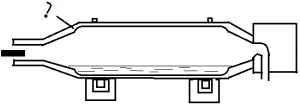
a) Burner
b) Exhaust box
c) Refractory lining
d) Molten metal
Answer
Answer: c [Reason:] In this given figure of a rotary melting furnace, the question mark is depicting the refractory lining, which is just below the steel shell. This lining has to be renewed after a certain usage.
6. In the given figure of a rotary melting furnace, what does the question mark depict?
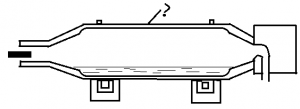
a) Steel shell
b) Exhaust box
c) Refractory lining
d) Molten metal
Answer
Answer: a [Reason:] The question mark is depicting the steel shell, which is the outer body of the furnace. The shape of this furnace is typically cylindrical.
7. In the given figure of a rotary melting furnace, what does the question mark depict?

a) Steel shell
b) Exhaust box
c) Refractory lining
d) Molten metal
Answer
Answer: b
8. In the given figure of a rotary melting furnace, what does the question mark depict?
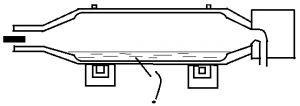
a) Steel shell
b) Exhaust box
c) Refractory lining
d) Molten metal
Answer
Answer: d [Reason:] In this given figure of a rotary melting furnace, the question mark is depicting the molten metal, which is then being heated and further treated for the production of malleable cast iron.
9. In the given figure of a rotary melting furnace, what does the question mark depict?

a) Exhaust box
b) Burner
c) Refractory lining
d) Molten metal
Answer
Answer: b [Reason:] Here the question mark is depicting the burner. This burner is situated at the opening of the furnace at its mouth. The burner simply burns the fuel and air mixture for heating operations.
10. The rotary furnace can have a capacity of 80 tons.
a) True
b) False
Answer
Answer: b [Reason:] A typical rotary melting furnace cannot have a capacity of 80 tons, the reason being, its minimum capacity to be 1 ton, and maximum capacity to be up to only 50 tons.
Set 5
1. Which of the following welding method is not used for salvaging?
a) TIG welding
b) MIG welding
c) Gas welding
d) Oxy-hydrogen welding
Answer
Answer: d [Reason:] In casting processes, there are many occasions on which a lot of material is wasted. Among the following, TIG welding, MIG welding and gas welding, are a few methods used in salvaging welding.
2. Which of the following is not a method of preparation of defective areas?
a) Chipping
b) Grinding
c) Rolling
d) Gouging
Answer
Answer: c [Reason:] In salvaging techniques, when a particular part has to be welded. Before the beginning of the weld, the defective part has to be prepared for it. Chipping, grinding and gouging are a few types of doing it.
3. Which of the following method is most suited for salvaging?
a) Brazing
b) Welding
c) Caulking
d) Plugging
Answer
Answer: b [Reason:] It is observed that, when the material which has been wasted, to be able to bring it to use, with the help of salvaging techniques, welding serves as the most appropriate operation than all others.
4. Which of the following is not an important property in terms of filler metals?
a) Thermal resistance
b) Chemical resistance
c) Corrosion resistance
d) Appearance
Answer
Answer: a [Reason:] When filler metals are considered, one has to be very careful while operating on it, as they play an important role in the weld characteristics. The thermal resistance has to be taken into account, but not as much as chemical resistance or corrosion resistance or the appearance of it.
5. Below what temperature does a solder melt?
a) 500°F
b) 600°F
c) 700°F
d) 800°F
Answer
Answer: d [Reason:] The process of soldering is very much similar to that of brazing, except for the temperature difference. In soldering process, the solder gets melted, when the temperature goes below 800°F.
6. Which of the following is not an impregnant?
a) Linseed oil
b) Sodium silicate
c) Silicon carbide
d) Synthetic resin
Answer
Answer: c [Reason:] Caulking and impregnation are one of the techniques used for salvaging defective castings. Among the following, linseed oil, sodium silicate and synthetic resins are regularly used as impregnants, but not sodium carbide.
7. At what temperature, is sodium silicate immersed in the cast for salvaging?
a) 125°F
b) 175°F
c) 225°F
d) 275°F
Answer
Answer: b [Reason:] Sodium silicate is a type of an impregnant, used for salvaging. The use of sodium silicate to immerse in the cast is termed as impregnation. The temperature at which this immersion should take place is between 175°F to 200°F.
8. For what time is a cast kept immersed in sodium silicate solution for salvaging?
a) 1 hour to 3 hours
b) 2 hours to 4 hours
c) 3 hours to 5 hours
d) 4 hours to 6 hours
Answer
Answer: b [Reason:] In impregnation technique of salvaging casts, the material has to be kept immersed inside the sodium silicate solution at a temperature between 175°F to 200°F, for about 2 hours to 4 hours.
9. Salvaging through welding is mainly focused on high alloy steels.
a) True
b) False
Answer
Answer: a [Reason:] Salvaging techniques, use the generated waste from casting processes in useful means by performing various operations on it like, welding, brazing and so on. Welding operation for salvaging is most suited for high alloy steels and more to iron.
10. Filling can be used for non-ferrous alloys.
a) True
b) False
Answer
Answer: a [Reason:] There is some sort of preparation required to the defective parts of the metal, before it is put for welding. When non-ferrous materials are to be prepared, filling serves as an option, before it is welded. Grinding is also one of the options for preparing non-ferrous materials.
